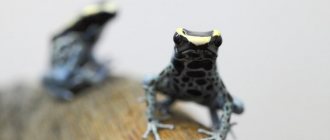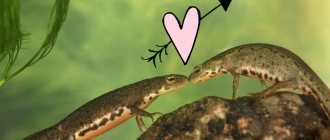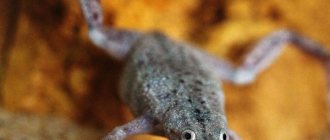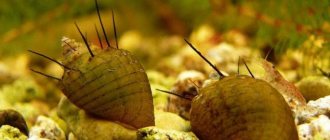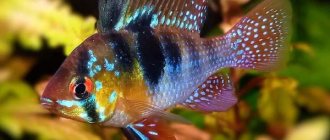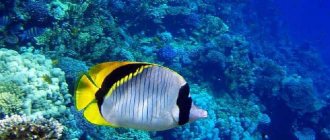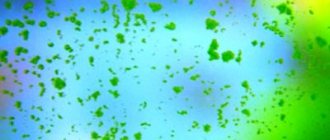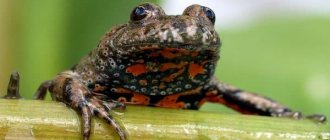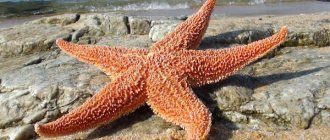Blue dart frog (Dendrobates azureus). (Image credit: Getty Images)
Poison dart frogs are small, brightly colored amphibians native to the tropical forests of Central and South America. They are members of the poison dart frog family (Dendrobatidae), and there are more than 175 known species, according to the San Francisco Zoo. According to the Rainforest Alliance, dart frogs are tiny, measuring between 2.5 and 5 centimeters in length, and, unlike many other amphibians, are diurnal, meaning they are active during the daytime. (, )
Poison dart frogs secrete toxins from their skin, which were traditionally used to make poisoned arrowheads and spears. For example, according to the American Museum of Natural History, the indigenous people of Embera and Noanam in western Colombia used the skin of the terrible leaf climber (Phyllobates terribilis) to shoot darts from a blowpipe for hundreds of years. ()
Darter frogs come in a variety of vibrant colors, which is why they are sometimes called "rainforest jewels." The bright colors of these frogs warn predators that they are poisonous and should be avoided. This survival mechanism is called aposematism. Some species of poison dart frogs also use their colors and patterns as camouflage. For example, the spotted poison dart frog (Dendrobates tinctorius) uses its bright yellow and black patterns to blend into its natural habitat. ()
The huge variety of colors among poison dart frog species may be the result of the frogs' ancestors splitting up about 10,000 years ago when what is now Panama was flooded, leading to the frogs becoming isolated in different places. According to the Smithsonian Institution, different populations of frogs then evolved their own colors. ()
Features of the view
Dart frogs are wild frogs, amphibians belonging to the family of the same name, the class of amphibians and the superorder of hoppers. They got their name due to the unique ability to move along the branches and leaf plates of trees, due to the specific structure of the limbs. After all, from the Greek language the word “tree climber” is translated as “climbing a tree.”
The natural habitat and historical homeland is Nicaragua, Peru, and the Panama Islands. However, today dart frogs, due to their original and bright appearance, unusual habits and behavior, have gained wide popularity among aquarists and terrarium keepers all over the world.
A distinctive feature of these amphibians is their skin, which performs a protective function by secreting a toxic poison that has a nerve-paralytic effect. Thus, nature itself took care to protect such marvelous creatures, whose population is invariably declining, from attacks by predators. After all, their color is so bright that it attracts everyone’s attention, and the poison dart frog is unlikely to be able to disguise itself or hide from the enemy.
It is this feature of the amphibian that every owner of such an exotic pet should remember and under no circumstances handle it with bare hands. It is not without reason that the ancient Indians used them to make poisonous arrows for hunting and battle.
However, according to many scientists, poisons that cause cardiac arrest and severe arrhythmia when they enter the bloodstream accumulate in poison dart frogs due to the consumption of ants and ticks, and if frogs are kept in an artificial environment and provided with a different diet, their toxicity indicators gradually are significantly reduced.
What happens when poisoned by frogs and toads?
The venom of tailless amphibians acts mainly on the circulatory and nervous systems and the heart. Of course, in order to be poisoned, say, by the poison of a toad, you must take it into your mouth. Naturally, no normal person would do this, but poisoning with the venom of the terrible leaf climber is known. It is enough to pick up an amphibian with your bare hands, and if there are cuts, abrasions and cracks on the skin, this can lead to severe poisoning and even death. Just imagine the state of a person when, as a result of the action of poison on the neuromuscular system, breathing begins to weaken. The inhalation becomes shallow and superficial. Gradually, oxygen deficiency occurs, and the victim begins to suffocate. The heart and brain also suffer from a catastrophic lack of oxygen, convulsions occur, and then death from respiratory arrest.
The mechanism of action of leaf climber poison is as follows. At the border of nerve and muscle there is a small special plate that has the properties of both nervous tissue and muscle tissue, which is why it is called the neuromuscular synapse, or connective tissue. The intercostal muscles also have such plates, which, together with the diaphragm, carry out the movement of air when inhaling into the lungs and when exhaling outward, i.e. carry out the breathing process. It is on these plates that the action of the “cocoe” poison is directed. By turning them off from work, the poison thereby stops the transmission of the signal from the nerve to the muscle. Naturally, the signal cannot pass through the disconnected plate; as a result, the muscles do not receive a signal from the nervous system to begin contraction and also stop working, i.e. breathing stops.
There are isolated cases of human death from toad poison. One of these cases occurred due to the fault of a healer, who advised the patient to get rid of a toothache in a very unique way: take a dried toad skin into your mouth and press it to your gums. This advice cost a man his life. Experts are well aware that in dried toad skin, poison can persist for up to ten years, practically without losing its properties.
Share with your friends:
Appearance and characteristics
Dart frogs are distinguished by their elegant structure and miniature size. The length of an adult does not exceed 12-13 cm. However, occasionally there are subspecies whose size is 60 or even 80 mm, but this is a huge rarity in nature. Females, as a rule, are much larger than males, and the latter have a more pronounced and rich color, which makes it easy to identify the gender of a particular individual.
Darter frogs have an unusual structure of the oral cavity ; they have absolutely no dentition. They absorb food by swallowing it with their long, elongated tongue . At the tips of the front and rear legs of poison dart frogs there are specific sticky triangular suction cups With their help, the amphibian easily and quickly moves along tree trunks and branches.
It is interesting that this type of amphibian completely lacks swimming organs, so they do not like to swim and generally try to avoid the aquatic environment. Therefore, when planning to get such an unusual pet, you should take care of purchasing and arranging for it a terrarium, and not an aquarium.
What impresses people most is the amazing, stunning coloration of poison dart frogs. These frogs are distinguished by extremely rich colors, which can vary from yellow-golden to deep scarlet or dark lilac tones. At the same time, the body of amphibians is covered with various spots and stripes, forming bizarre patterns. The skin of the dart frog has a pronounced glossy sheen, which looks especially impressive in bright sunlight or intense artificial lighting.
In the thigh area there are bluish spots with a specific metallic tint. In many ways, the coloring of the poison dart frog depends on its specific subspecies and the characteristics of its keeping. However, in any case, each representative of this type of amphibian looks unique and seems like a space alien from another planet, which largely determines their wide popularity and demand among terrarium enthusiasts.
Dart frogs also have one more specific feature that distinguishes them from other frogs - they never croak, but make peculiar whistling, buzzing or chirping sounds, which, according to many people, sound very melodic and pleasant.
Dart frogs are social amphibians and do not tolerate loneliness well, so in their natural habitat they live in small colony groups. For this reason, experts recommend that terrarium keepers who decide to get such a pet purchase at least 3-4 individuals at once.
Dart frogs are diurnal and are not shy, so observing their habits and behavior is no less exciting than admiring the exotic beauty of these amazing frogs.
Darter frogs live both on the ground, in the thick of bushes, on sandy slopes, and on the tops of trees, it all depends on the specific subspecies. However, judging by the reviews of aquarists themselves, most individuals have excellent adaptive abilities and quickly get used to new living conditions.
Morphs [edit]
The species includes a wide variety of coloration and pattern variations (subspecies and morphs). Some batrachologists suspect that these are indeed different species.
- D. tinctorius
'Patricia'
- D. tinctorius
- D. tinctorius
- D. tinctorius
(left) with
Epipedobates anthonyi - D. tinctorius "azure"
- D. tinctorius
'Giant Orange'
- D. tinctorius
'Citronella'
Lifestyle and nutrition in the natural environment
By nature, dart frogs are considered predators. They prefer to feed on midges, termites, bugs, beetles, centipedes, and various types of small insects. The process of hunting and eating food occurs with the help of the tongue. Moreover, poison dart frogs react exclusively to moving objects moving in space.
However, they cannot be called passive either. Having seen potential prey, dart frogs will chase it until they overtake it or lose sight of it. The process of searching and obtaining food takes up most of the time of poison dart frogs. This is due to accelerated metabolism and metabolism, which is why, if left without food for just a couple of days, the poison dart frog may even die.
Amphibians do not disdain plants, happily eating various herbs, fruits, and greens. Young poison dart frogs are fed using their own unfertilized eggs for these purposes. Dart frogs are calm and always feel protected thanks to the poisons they secrete and the unpleasant taste that causes a strong burning sensation. For most predators, they are not tempting prey.
The only thing these miniature creatures fear is tropical downpours. Firstly, they simply do not like water, and secondly, too large drops of rain can destroy an elegant frog. Therefore, during periods of rain, they find a secluded and safe shelter for themselves. They also have difficulty withstanding cold and sudden temperature changes. Even a slight frost can cause death for poison dart frogs.
Human use of poison
Previously, the mucus of poisonous frogs was used for its intended purpose - to hunt game and destroy enemies. The skin of the American spotted poison dart frog contains so much poison (BTXs + homobatrachotoxin) that it is enough for dozens of arrows that can kill or paralyze large animals. The hunters rubbed the tips on the back of the amphibian and tucked the arrows into their blowguns. In addition, biologists have calculated that the poison of one such frog is enough to kill 22 thousand mice.
According to some sources, the role of a primitive drug was the poison of the aga toad: it was simply licked from the skin or smoked after drying it. Nowadays, biologists have come to the conclusion that the poison of Bufo alvarius (Colorado toad) is a more powerful hallucinogen - it is now used for relaxation.
Also, from the skin of tailless amphibians, biochemists have isolated a peptide that prevents the multiplication of the HIV virus (but this research has not yet been completed).
Varieties of dart frogs
Most subspecies are active throughout the year and do not hibernate. Both external data and behavioral characteristics, conditions of detention largely depend on the species of poison dart frog. Therefore, it is important for the terrarium owner to familiarize himself with information regarding the most common subspecies in order to make a choice and provide the pet with competent care.
Blue dart frog
A miniature creature whose weight category does not exceed 8 g. It has a rich blue body color with characteristic spots and stripes, as well as blue splashes on the sides. Blue dart frogs lead an exclusively gregarious lifestyle, forming small colonies, living near bodies of water in bushes or among stones.
This subspecies is endangered. Therefore, according to the laws, taking it outside its natural habitat and keeping it at home is strictly prohibited. However, the blue poison dart frog is not popular anyway due to the increased toxicity and toxicity of its secretions, which can cause cardiac arrest in just a few minutes.
The leaf climber is terrible
This frog is the most poisonous on the entire globe, which is why it received such a terrifying name. The size of an adult individual ranges from 25 to 45 cm. The coloring is predominantly yellow and golden tones, only the lips, nose and eyes, as well as the underside of the paws, are black.
The terrible leaf climber is the only member of the poison dart frog family that has small teeth located in the lower jaw. Lives in mountain and tropical forests. The venom of this creature is deadly to all living organisms, with the exception of the lyophis snake.
Spotted frog (or dye frog, spotted tree frog, dye frog)
This subspecies differs from its relatives in the maximum variety of colors and sizes. In most cases, the back of the frog is white, with black spots and stripes that form original patterns, and the legs are painted black or dark blue. However, in nature there are spotted dart frogs, the colors of which are dominated by black, yellow, green, silver and orange shades.
The skin secretions of the spotted dyer are highly toxic, thanks to which it is well protected from enemies. But, despite this, this subspecies of poison dart frogs is on the verge of extinction, and therefore is strictly protected.
Dapper Darter
This frog, also known as the tricolor dart frog, is dark brown or burgundy in color. The dimensions are about 20-25 cm. Like other representatives of this family, the entire body of the amphibian is covered with spots, mostly black, brick or scarlet.
Dapper poison dart frogs have been selectively bred, having other colors, but they are very rare and are not found at all in the natural environment.
It is the dapper dart frogs that are most often bred in terrariums, since they easily adapt to new living conditions and have secretions of moderate toxicity. And after some time, as a result of adaptation and living in an artificial environment, they completely cease to be dangerous to humans.
Mysterious
The mysterious poison dart frog is considered one of the largest subspecies, since the size of an adult individual is, on average, about 30 cm. They are black in color with bright white spots located along the entire body. They live mainly in the mountains and descend to the ground only periodically, most often when a wet period begins.
Sacred Treecreeper
The sacred poison dart frog is an extremely cute and tiny amphibian, whose weight category does not exceed 3 g. Moreover, its colors are one of the brightest, most spectacular and unusual among poison dart frogs. On the dominant black tone of the frog’s skin there are contrasting stripes and spots of rich yellow, orange, and golden hues.
Another distinctive feature is that they hibernate during the dry season. However, when kept in artificial conditions with the required level of humidity and temperature conditions, the frog remains active throughout the whole year.
The amphibian received its unusual name because, according to historical data, it was considered sacred and especially revered among the ancient Indians. There is still a legend that such an unusual pet will bring good luck and financial well-being to its owner. Perhaps this, as well as the frog’s spectacular appearance and unpretentiousness in terms of care, made it especially popular among terrarium hobbyists.
Small poison dart frog
The name of this subspecies already speaks for itself; its dimensions do not exceed 17 cm. The dart frog has a specific and eye-catching color. Thus, the tummy of a small poison dart frog can be painted red, blue or white, the legs have a black tint. The back and surface of the amphibian's body are orange or scarlet with interesting dotted patterns along the entire body.
Quite poisonous, but nevertheless sometimes successfully kept at home. The main thing is to provide the pet with an environment close to its natural habitat and try not to touch it without wearing special protective gloves.
Coloring
A very interesting subspecies of dart frogs, the height of individuals of which can reach 42 cm. If the mucus of this amphibian is applied to down or bird feathers, they will acquire an atypical red or yellow color after the molting process. Thanks to this unique feature, this poison dart frog got its unusual name - dyeing.
Black representatives of this species are most often found in nature; brown or green individuals are less common. Along their body there are characteristic bronze, black, turquoise, white spots, lines and polka dots.
The frog spends most of its life on the tops of trees, hiding in dense foliage. The secretions of the dye dart frog are very toxic, so it is not recommended to keep it at home.
Elegant
A miniature and fragile amphibian of black or brown color. The body is covered with numerous spots of red, orange or gold tones. It is interesting that in these representatives of the poison dart frog family, the males are much larger than the females, although in other amphibians everything is the other way around.
The graceful poison dart frog has good adaptability and easily adapts to new living conditions, and therefore is quite suitable for keeping in terrariums.
Cross-striped
The frog got its name for its specific color - on a black or dark brown background there are two smooth orange side stripes. The paws can be either green or black. The average size of individuals is about 30 cm. The amphibian leads a secretive lifestyle, prefers solitude, emerging from its shelter only for the purpose of obtaining food.
Yellowstriped
One of the smallest species of poison dart frogs, the length of which does not reach 40 mm. The color may be different, but the main tone of the skin always contains pronounced rich yellow stripes. They can live in different conditions and are excellent for keeping in an artificial environment.
Two-color leaf climber
The two-colored poison dart frog is on the verge of extinction and is therefore listed in the Red Book. Hunting these amphibians, as well as keeping them at home, is prohibited by law. This species is the largest among poison dart frogs. The size of an adult individual can reach 50-55 cm.
The color can be yellow or orange; amphibians with a dominant brown skin tone are much less common. In this case, the lower part of the body and legs are painted black or blue. It is thanks to the combination of two shades in color that the leaf climber received the name two-color.
They lead a solitary lifestyle, forming pairs or colonies only during the breeding season or when there is potential danger. The poison of the leaf climber is very toxic; only the terrible leaf climber is considered more poisonous. Penetrating into the bloodstream, the secretions of the bicolor dart frog paralyze the muscles of the human respiratory system, causing almost instant death.
Citronella
This is one of the forms of spotted poison dart frogs, which is considered by specialists and terrariumists to be the most beautiful and attractive in appearance. The sides and back of the frog have a bright yellow color, which combines surprisingly harmoniously and effectively with black or deep blue legs. The miniature nature of this amphibian is also surprising, its dimensions sometimes not even reaching 7 cm. Citronella prefers to lead a terrestrial lifestyle, often choosing a sandy shore or recesses under the rhizomes of large trees as its habitat.
This species of spotted poison dart frog is quite rare. An interesting feature is that they live in pairs. Moreover, males and females of citronella form a pair not only for the breeding season, but also remain faithful to each other throughout their lives. This phenomenon is considered extremely rare not only for poison dart frogs, but also among amphibians in general.
Citronellas are very sought after and popular amphibians. Often found in terrariums and aquariums. Recently, they have been bred through artificial selection. It is noteworthy that, unlike other dart frogs, these frogs reproduce extremely rarely; their mating season occurs no more often than once every six months.
Amazonian
It is considered one of the most active, energetic and mobile representatives of poison dart frogs. Feeds on small insects. He prefers to spend most of his time among trees and foliage. Suitable for keeping in a terrarium when creating optimal living conditions for it.
Yellow-red
The yellow-red poison dart frog is the rarest of all representatives of its family. It has a characteristic color in golden and red tones with various variations of shades. Usually lives in tropical forests or thickets of small-sized plants with large leaf blades.
Charming leaf climber / Phyllobates lugubris
The species name of the inhabitant of the Atlantic coast of Central America fully corresponds to the appearance of the frog. Multi-colored stripes run along the black body, from yellow to bright golden.
Not as poisonous as other representatives of the leaf climber genus, but able to defend itself from natural enemies. Possessing poison, it does not hide much, so it can easily be found on forest paths and the banks of rivers and reservoirs.
They are distinguished by leaf climbers and huge bulging eyes on a relatively small head.
9
How does reproduction work?
In their natural habitat, poison dart frogs reproduce naturally. Individuals reach sexual maturity at approximately six months. However, some varieties acquire the ability to reproduce no earlier than one and a half years of age. Interestingly, dart frogs, with the exception of the sacred subspecies and citronella, reproduce throughout the whole year.
The amazing care for their offspring and the pronounced parental instincts of poison dart frogs, which are rarely found in other amphibians, are striking. During the mating season, males organize a secluded place for breeding and raising babies and attract females with their loud cries, and they already choose a potential candidate, focusing primarily on the brightness of the color, the power of the voice, as well as the degree of comfort of the “family nest” equipped by him. .
The process of reproduction itself takes place quite unusually, without traditional sexual intercourse. To produce offspring, the male tightly clasps his partner’s head and, after laying eggs, fertilizes her. However, among some subspecies, especially among the representatives of the most miniature poison dart frogs, reproduction proceeds in exactly the opposite way. That is, first the male secretes seminal fluid, and the female already breaks off her eggs into it.
After the eggs hatch, one of the parents is always near them to guard and protect the future offspring from potential dangers, predators and enemies. Periodically, poison dart frogs moisten the eggs with water and mix them with their paws. The average incubation period is about 2 weeks. After which small tadpoles are born.
An interesting fact is that the gender of the future offspring of poison dart frogs is significantly influenced by temperature conditions. In hot climates, the birth of males dominates. At lower temperatures, more females are born. Dart frogs take very careful and attentive care of their babies and look after them. Moreover, not only the female, but also the male takes part in this process.
Since babies need an increased amount of moisture and an aquatic environment, parents secure them on their backs (this is facilitated by a kind of mucous secretion that forms only during reproduction and raising offspring). Then the tadpoles are transferred to various places where there is accumulation of water.
Depending on the habitat, size and characteristics of a particular subspecies of poison dart frog, this may be a small pond, a leaf rosette with accumulation of rainwater, liquid-filled tree hollows, etc. Moreover, wanting to provide their babies with maximum comfort, whenever possible, dart frogs try to place no more than one tadpole in the tank.
It should be noted that among the majority of young representatives of the poison dart frog family, cannibalism is highly developed, and in order to satisfy the feeling of hunger, they may well eat their fellows. To prevent this from happening, parents try to feed the cubs with unfertilized eggs, which allow the tadpoles to get enough and provide their body with the necessary amount of valuable nutrients and elements for full growth and development.
The duration of growth and development of babies can vary from 2 weeks to 3 months, depending on the specific variety of frog.
After this, young poison dart frogs are separated from their parents and begin an independent life in the terrestrial environment.
Dangerous frog-monkey
Phyllomedusa bicolor is a very large frog belonging to the tree frog family. Distributed in tropical forests of South America. The upper part of the amphibian’s body is colored light green, while the abdomen can be cream, light yellow or white. The interesting way Phyllomedusa bicolor moves along tree branches makes it very similar to a monkey or chameleon, which is how this amphibian earned its second nickname - monkey frog, or monkey frog.
The way Phyllomedusa bicolor moves along tree branches makes it very similar to a monkey.
Local residents idolize this amphibian, believing that the poisonous substance secreted by its skin can cure any disease. Thus, the aborigines believe that the venom of phyllomedusa, which has entered the human body, is capable of driving away bad energy, thereby restoring luck, stamina and lost male sexual qualities. Toxic mucus is often used to heal snake bites, as well as to treat yellow fever, malaria, etc.
The poison of a frog is obtained in a very interesting way: it is stretched by its legs (in an X shape), and then spit on its back 3-4 times, thereby irritating the phyllomedusa, which immediately begins to secrete the necessary secretion. Next, the poison is collected with a wooden spatula, and the amphibian is released into the wild.
The aborigines believe that the venom of the phyllomedusa, which has entered the human body, is capable of driving away bad energy.
The method of using toxic mucus is also quite unusual: several small burns are applied to the aborigine’s right forearm with coal from a fire, after which these wounds are generously smeared with the resulting substance. The toxic effect manifests itself almost immediately: the heartbeat increases, blood pressure rises, then dizziness, nausea and vomiting begin. Some people lose consciousness. After about 30-40 minutes, the effect of the poison ends, and the subjects return to normal, after which they joyfully and cheerfully go about their business.
About the benefits of dart frogs
Dart frogs are not only beautiful, but also bring great benefits. Firstly, these miniature creatures destroy many insects, thus regulating their population and numbers. Secondly, modern specialists and scientists have found several ways to use the toxic secretions of dart frogs for medicinal purposes:
- Creation of an innovative antibiotic drug, which is already undergoing testing and clinical trials, and will soon appear on the pharmaceutical market.
- The dye dart frog secretes a specific substance - epibatidine, which has pronounced analgesic and analgesic properties that are several hundred times greater than the effect of morphine. Several medications are also being developed based on it.
- An insecticide made from poison dart frog secretions is already on sale and is in great demand due to its high efficiency and absolute safety for human health.
Separately, we should talk about the poisons secreted by poison dart frogs and their properties. Indeed, most secretions have a high degree of toxicity, leading to death. But, firstly, when living in an artificial environment, it disappears, and secondly, the poison can penetrate into the bloodstream only if you take the frog with your bare hands, if there is damage to the integrity of the skin or in contact with the mucous membranes.
Further reading[edit]
Born, Marga; Bongers, Franz; Poelman, Eric; Sterk, Frank (June 2010). "Dry season retreat and dietary changes in the frog Dendrobates tinctorius (Anura: Dendrobatidae)". Phyllomedusa
.
9
(1): 37–52. DOI: 10.11606/issn.2316-9079.v9i1p37-52. Retrieved April 20, 2015.
Ringler, Eva; Rojas, Viviana; Ringler, Max; Hoedl, Walter (October 2012). "Characterization of nine polymorphic microsatellite loci in the dye poison frog Dendrobates tinctorius (Dendrobatidae) and their interspecific application in two other dendrobatoid species." Herpetological Journal
.
22
(4): 263–265. ISSN 0268-0130.
Rojas, Viviana; Endler, John A. (June 22, 2013). "Sexual dimorphism and intrapopulation color variation in the aposematic frog Dendrobates tinctorius." Evolutionary ecology
.
27
(4): 739–753. DOI: 10.1007/s10682-013-9640-4. S2CID 13669947.
What is dangerous for poison dart frogs?
Despite the fact that dart frogs are toxic and therefore not edible, there are still some predatory animals that are not sensitive to the poisons secreted by these amphibians. These include large snakes and spiders, which pose a serious potential danger to poison dart frogs.
In their natural habitat, dart frogs live for about 20 years and rarely get sick. The only disease to which these amphibians are susceptible is various fungal infections. In addition, the delicate and sensitive skin of amphibians often causes traumatic injuries, sometimes fatal to poison dart frogs. Frogs can die both from the wounds themselves and from purulent processes and blood poisoning.
Yeah / Rhinella marina
The poisonous tropical toad takes an honorable second place among all toads, but its toxicity makes it a leader among poisonous amphibians.
The largest specimen reached a size of 24 cm, although on average the toad grows from 15 to 17 cm. It comes from Central America, but to fight insects they were brought to Australia, from where Aga settled on the islands of Oceania.
The strongest poison affects the heart and affects the nervous system. The most dangerous thing is that the green toad can shoot poison over a distance.
1
Is it possible to keep dart frogs at home?
In fact, dart frogs are wild frogs that are not adapted to life in captivity. But many subspecies have a good ability to adapt and, if optimal conditions are created, can live a long time and maintain excellent health in an artificial habitat.
First of all, when planning to get such a pet, you should take care of purchasing a spacious and transparent terrarium.
The optimal volume of the tank should be about 30-40 liters, depending on the number of its potential inhabitants.
The tank must be equipped with a special protective cover or glass with holes for ventilation, since poison dart frogs often jump out and climb out of the terrarium, climbing up its walls. And this is fraught with the imminent death of the amphibian as a result of dehydration and exhaustion of the body.
To create optimal comfortable conditions close to the usual natural habitat of poison dart frogs, it is recommended to decorate the terrarium with various stones, driftwood, tree branches, and greenery with large leaf plates.
The ideal soil for dart frogs would be soil intended for growing ornamental plants, which can be freely purchased at any specialty store. Moss, leaves, and pieces of tree bark must be laid on top of the soil. Moreover, it is important to ensure that the soil is always sufficiently moist.
It is very important that both the terrarium itself and the decorative elements present in it do not have sharp edges or protrusions, since all poison dart frogs are characterized by extremely delicate, sensitive skin and a tendency to receive dangerous traumatic injuries.
Terrible leaf climber / Phyllobates terribilis
A small inhabitant of the rainforests on the southwestern tip of Colombia, the most poisonous frog in the world.
Adults grow no more than 2–4 cm, and the color is contrasting and quite bright. Yellow frogs are so poisonous that even a slight touch to it is enough to cause death. Phyllobates terribilis is born non-poisonous, and then, by consuming insects, it produces poison.
The most interesting thing is that in captivity, the Colombian poison frog gradually loses its poisonousness, since the diet does not contain insects, which contribute to the production of the deadly poison.

